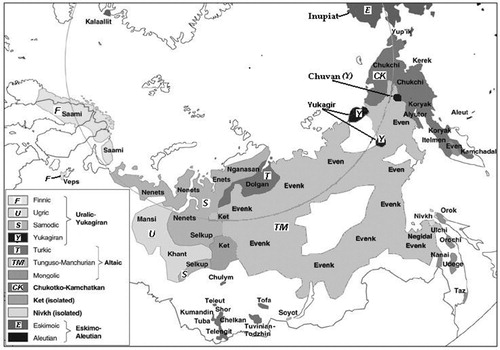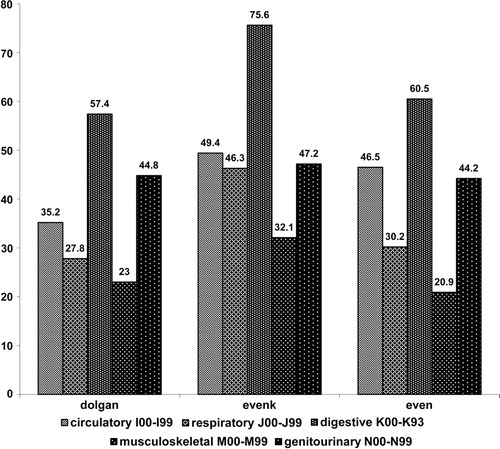Abstract
Background
Native people of the Republic of Sakha (Yakutia) live mostly in northern regions in the so-called “national settlements”. Natives usually experience more health-related problems as compared to the total population. As a result, life expectancy at the birth of Natives living in the Republic of Sakha (Yakutia) is lower compared to ethnic groups living in European countries, in the United States, and in Canada.
Objective of the study
To determine the prevalence of diseases among Natives living in Yakutia and to compare the standards of living for Dolgans living in the Anabarsky region and Evenks living in Gigansky and Ust-Maysky regions.
Study design/methods
The study was designed as a population-based, cross-sectional examination with the addition of a cross-sectional survey for Dolgans and Evenks. Data were obtained from 324 Evenks, 43 Evens, 230 Dolgans, and 216 people of other ethnic groups, aged 17–86. In the additional cross-sectional survey, 155 Dolgans and 292 Evenks were included.
Results
Among Natives, the most prevalent diseases are digestive diseases (67.9 cases per 100 examined), diseases of the genitourinary system (45.3 per 100 examined), circulatory system diseases (44.4 per 100 examined), diseases of the respiratory system (36.9 cases per 100 examined) and diseases of the musculoskeletal system and connective tissue (28.4 cases per 100 examined). There are differences in the prevalence among Natives living in different regions. Anabarsky region has the lowest disease burden and Dolgans inhabiting this region have higher standards of living than Evenks living in Gigansky and Ust-Maysky regions.
Conclusions
The prevalence of diseases among the Natives, living in the Republic of Sakha (Yakutia), is very high. Differences in raw prevalence rate between Native ethnic groups were found, but it is unknown whether these differences can be assigned rather to the difference in standards of living in the inhabited locality than to ethnicity itself.
Indigenous people living in the Republic of Sakha (Yakutia), who are jointly called Natives, can be divided into 5 major ethnic groups: Evens, Evenks, Yukagirs, Chukchi and Dolgans belonging to 4 language families (). This grouping is based on cultural and linguistic similarities of people living in different—mostly northern—regions of the Republic of Sakha (Yakutia) mainly in the so-called “national settlements” where the number of Native families as a rule is more than 60%. Lifestyle, labour activity and food preferences of the Natives, being dependent to some extent on the ethnicity of the community, is mostly influenced by the environment (tundra, forest, sea shore, bank of a river).
Fig. 1 Indigenous peoples of the North, Siberia and Far East of the Russian Federation, subdivided according to language families. Polar Circle is marked with grey line (Citation1).

Indigenous people usually experience more health related problems as compared to the total population (Citation2–Citation5). Their health status and outcomes are embedded within the specific socio-economic, political and cultural contexts, as well as influenced by ecology issues. It is also known that the number of consanguineous marriages in Yakutia, including first-cousin unions, is rather high (Citation6).
As a result, life expectancy at birth of Natives living in the northern European, Far Eastern regions of the Russian Federation and in Siberia is significantly lower compared to ethnic groups living in European countries, US, and Canada (Citation7).
Objective of this study is to determine the prevalence of diseases among Natives living in Yakutia and to compare the standards of living for Dolgans living in the Anabarsky region and Evenks living in Gigansky and Ust-Maysky regions.
Materials and methods
The study was designed as a population-based, cross-sectional examination, based on the results of the longitudinal analysis of national and regional reports of the Yakut Healthcare services, performed according to the standard diagnostic programs with the addition of a cross-sectional survey for Dolgans and Evenks.
Analysis included 813 people (547 women—67.3%; 266 men—32.7%) aged 17–86 years (average 44.0±1.7 years), living in Gigansky, Ust-Maysky and Anabarsky regions of Yakutia. The following were included: Evenk—324 (40%), Even—43 (5%), Dolgans—230 (28%), others—216 (27%). Examinations were performed by a group of medical specialists including cardiologists, pulmonologists, neurologists, gastroenterologists, ENT-specialists, urologists, gynaecologists, endoscopists and specialists in medical ultrasonography.
In the additional cross-sectional survey, a total of 447 Natives were surveyed (155 Dolgans and 292 Evenks).
To determine the significance of differences, a 2-sample t-test was used. To determine the significance of the difference between percentages, a 2-sample t-test between percentages (independent samples) was used (Statistics calculator, StatPac, ver. 4).
Results
It was found that among Natives living in the Republic of Sakha (Yakutia), the most prevalent diseases, on average, are digestive diseases (67.9 cases per 100 examined), diseases of the genitourinary system (45.3 per 100 examined), circulatory system diseases (44.4 per 100 examined), diseases of the respiratory system (36.9 cases per 100 examined) and diseases of the musculoskeletal system and connective tissue (28.4 cases per 100 examined) ().
Table I Native people of Yakutia: average prevalence of diseases in terms of the International Statistical Classification Of Diseases And Related Health Problems 10th Revision
Selected results of comparative analysis of the prevalence of the most common diseases in Ust-Maysky, Gigansky and Anabarsky regions of the Republic of Sakha (Yakutia) are presented in . Presented data show that there are somewhat great differences in the prevalence among Natives living in different regions; the Anabarsky region appears to have the lowest disease burden.
Table II Native people of Yakutia: average prevalence of diseases in different regions in terms of the International Statistical Classification of Diseases and Related Health Problems 10th Revision
The results of comparative analysis of the prevalence of the most common diseases in subpopulations of Evens, Evenks and Dolgans—the main studied ethnic groups—are shown in . Although differences can be seen, there are not enough data to distinguish the differences related to ethnicity and to inhabited locality separately.
Fig. 2 Native people of Yakutia: prevalence of diseases (per 100 examined) in different ethnic groups in terms of the International Statistical Classification of Diseases and Related Health Problems 10th Revision.

Selected results of the survey analysis are shown in . Comparison of characteristics No. 2–6, presented in , shows that the standards of living for Evenk people are significantly lower than that for Dolgan people.
Table III Selected results of the survey analysis
Conclusions
The prevalence of diseases among the Natives living in the Republic of Sakha (Yakutia) is very high specifically for digestive diseases, diseases of the genitourinary system, circulatory system, respiratory system, musculoskeletal system and connective tissue.
Statistically significant differences in raw prevalence rates between Native ethnic groups were found, but it is unknown whether these differences can be assigned to the difference in standards of living in the inhabited locality rather than to ethnicity itself.
Standard of living for Dolgans who live in Anabarsky region is significantly higher compared with the standard of living indicators for Evenks inhabiting Gigansky and Ust-Maysky regions of the Republic of Sakha (Yakutia).
The results of the study are the basis for assessment of disease burden in subpopulations of Natives and also for the individualization of health care programs.
Conflict of interest and funding
This Presentation Covers the Results of the Research Supported by a Grant “Health Assessment and Optimization of Medical Care to the Natives of Yakutia in Terms of Innovation and Telemedicine” (State Program, Grant #636).
References
- Indigenous peoples of the North, Siberia and Far East of the Russian Federation, subdivided according to the language families. [cited Mar 27 2013]. Available from: http://ansipra.npolar.no/english/Indexpages/Map_index.html.
- Ahmed SM, Rafi M, Chowdhury AMR. Health-care facilities, contraception, and ante-natal care services. Counting the Hills: assessing development in Chittagong Hill Tracts. 2001; Dhaka: The University Press Ltd. 167–73.
- Altman J, Neil Thomson N. The social and economic context of indigenous health. The health of indigenous Australians. 2003; Melbourne: Oxford University Press. 25–43.
- Bjerregaard P, Young TK, Dewailly E, Ebbesson SE. Indigenous health in the Arctic: an overview of the circumpolar Inuit population. Scand J Public Health. 2004; 32: 390–5.
- Rakibul I, Mashhood AS. Cultural and socio-economic factors in health, health services and prevention for indigenous people. Antrocom Online J Anthropol. 2010; 6: 263–73. [cited 2013 Mar 27]. Available from: http://www.antrocom.net/upload/sub/antrocom/060210/12-Antrocom.pdf.
- Maksimova NR. Clinical, genealogical and molecular genetic characteristics of ethno-specific inherited pathology in Yakuts [dissertation].
- Young TK. Circumpolar health indicators: sources, data, and maps. Circumpolar Health Suppl. 2008; 3: 1–130.